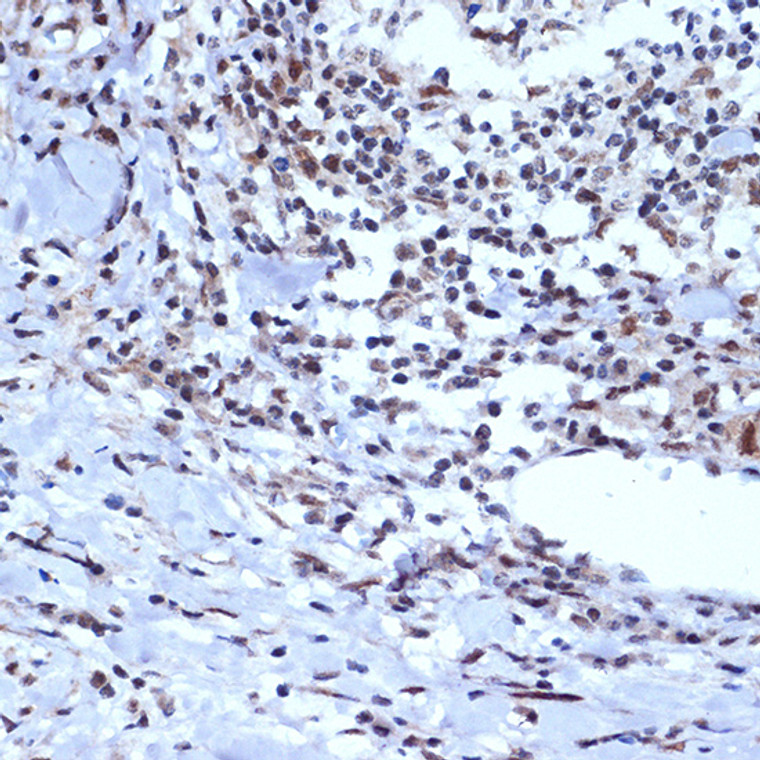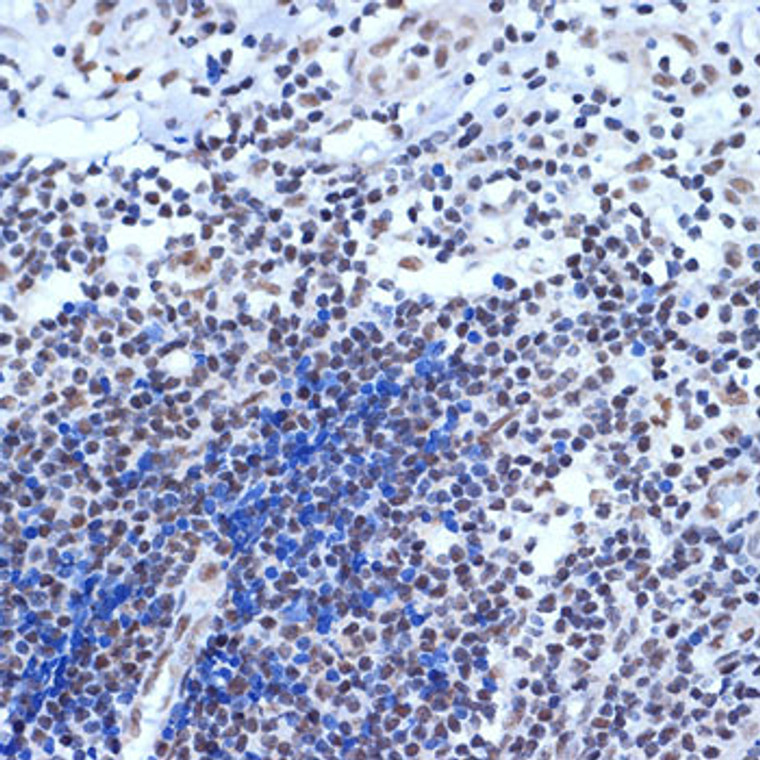| Host: |
Rabbit |
| Applications: |
WB/IHC |
| Reactivity: |
Human/Mouse/Rat |
| Note: |
STRICTLY FOR FURTHER SCIENTIFIC RESEARCH USE ONLY (RUO). MUST NOT TO BE USED IN DIAGNOSTIC OR THERAPEUTIC APPLICATIONS. |
| Short Description: |
Rabbit monoclonal antibody anti-ACTL6A (201-290) is suitable for use in Western Blot and Immunohistochemistry research applications. |
| Clonality: |
Monoclonal |
| Clone ID: |
S9MR |
| Conjugation: |
Unconjugated |
| Isotype: |
IgG |
| Formulation: |
PBS with 0.02% Sodium Azide, 0.05% BSA, 50% Glycerol, pH7.3. |
| Purification: |
Affinity purification |
| Dilution Range: |
WB 1:500-1:2000IHC-P 1:50-1:200 |
| Storage Instruction: |
Store at-20°C for up to 1 year from the date of receipt, and avoid repeat freeze-thaw cycles. |
| Gene Symbol: |
ACTL6A |
| Gene ID: |
86 |
| Uniprot ID: |
ACL6A_HUMAN |
| Immunogen Region: |
201-290 |
| Immunogen: |
Recombinant fusion protein containing a sequence corresponding to amino acids 201-290 of human ACTL6A (O96019). |
| Immunogen Sequence: |
FITMQCRELFQEMNIELVPP YMIASKEAVREGSPANWKRK EKLPQVTRSWHNYMCNCVIQ DFQASVLQVSDSTYDEQVAA QMPTVHYEFP |
| Function | Involved in transcriptional activation and repression of select genes by chromatin remodeling (alteration of DNA-nucleosome topology). Component of SWI/SNF chromatin remodeling complexes that carry out key enzymatic activities, changing chromatin structure by altering DNA-histone contacts within a nucleosome in an ATP-dependent manner. Required for maximal ATPase activity of SMARCA4/BRG1/BAF190A and for association of the SMARCA4/BRG1/BAF190A containing remodeling complex BAF with chromatin/nuclear matrix. Belongs to the neural progenitors-specific chromatin remodeling complex (npBAF complex) and is required for the proliferation of neural progenitors. During neural development a switch from a stem/progenitor to a postmitotic chromatin remodeling mechanism occurs as neurons exit the cell cycle and become committed to their adult state. The transition from proliferating neural stem/progenitor cells to postmitotic neurons requires a switch in subunit composition of the npBAF and nBAF complexes. As neural progenitors exit mitosis and differentiate into neurons, npBAF complexes which contain ACTL6A/BAF53A and PHF10/BAF45A, are exchanged for homologous alternative ACTL6B/BAF53B and DPF1/BAF45B or DPF3/BAF45C subunits in neuron-specific complexes (nBAF). The npBAF complex is essential for the self-renewal/proliferative capacity of the multipotent neural stem cells. The nBAF complex along with CREST plays a role regulating the activity of genes essential for dendrite growth. Component of the NuA4 histone acetyltransferase (HAT) complex which is involved in transcriptional activation of select genes principally by acetylation of nucleosomal histones H4 and H2A. This modification may both alter nucleosome - DNA interactions and promote interaction of the modified histones with other proteins which positively regulate transcription. This complex may be required for the activation of transcriptional programs associated with oncogene and proto-oncogene mediated growth induction, tumor suppressor mediated growth arrest and replicative senescence, apoptosis, and DNA repair. NuA4 may also play a direct role in DNA repair when recruited to sites of DNA damage. Putative core component of the chromatin remodeling INO80 complex which is involved in transcriptional regulation, DNA replication and probably DNA repair. |
| Protein Name | Actin-Like Protein 6a53 Kda Brg1-Associated Factor AActin-Related Protein Baf53aArpnbetaBrg1-Associated Factor 53aBaf53aIno80 Complex Subunit K |
| Database Links | Reactome: R-HSA-3214847Reactome: R-HSA-3214858Reactome: R-HSA-5689603Reactome: R-HSA-5696394Reactome: R-HSA-8939243 |
| Cellular Localisation | Nucleus |
| Alternative Antibody Names | Anti-Actin-Like Protein 6a antibodyAnti-53 Kda Brg1-Associated Factor A antibodyAnti-Actin-Related Protein Baf53a antibodyAnti-Arpnbeta antibodyAnti-Brg1-Associated Factor 53a antibodyAnti-Baf53a antibodyAnti-Ino80 Complex Subunit K antibodyAnti-ACTL6A antibodyAnti-BAF53 antibodyAnti-BAF53A antibodyAnti-INO80K antibody |
Information sourced from Uniprot.org
12 months for antibodies. 6 months for ELISA Kits. Please see website T&Cs for further guidance











